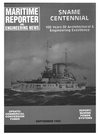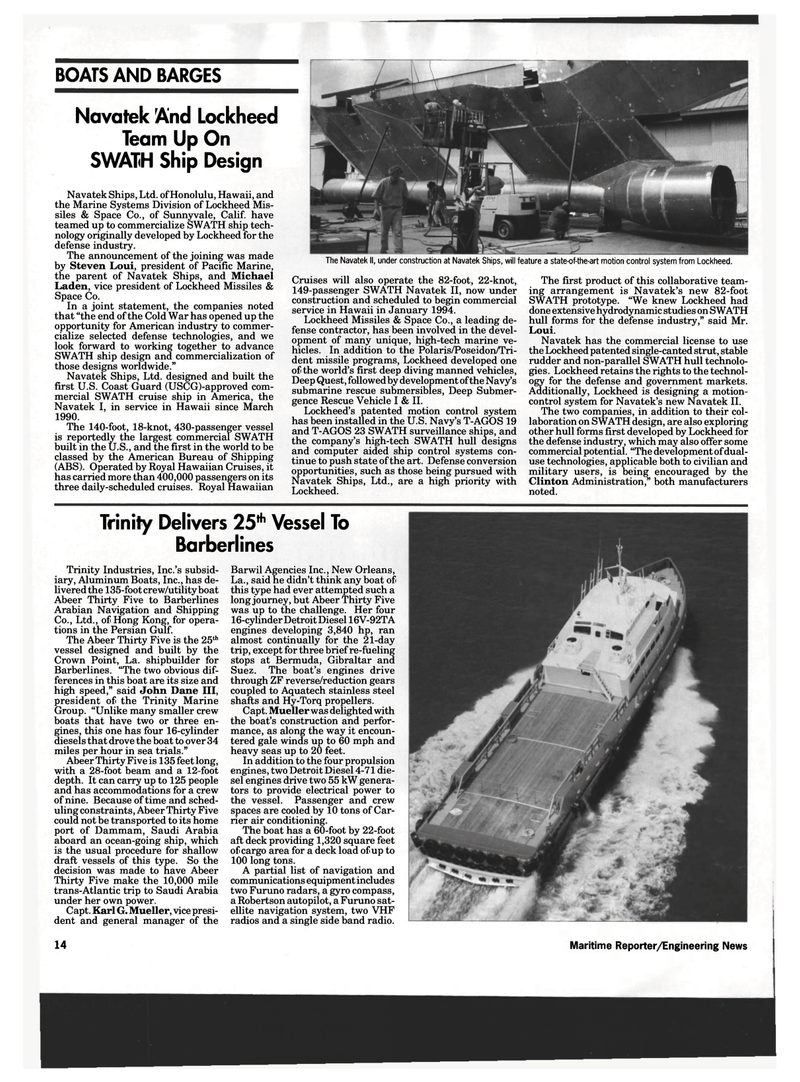
Page 12: of Maritime Reporter Magazine (September 1993)
Read this page in Pdf, Flash or Html5 edition of September 1993 Maritime Reporter Magazine
BOATS AND BARGES
Navatek And Lockheed
Team Up On
SWATH Ship Design
Navatek Ships, Ltd. of Honolulu, Hawaii, and the Marine Systems Division of Lockheed Mis- siles & Space Co., of Sunnyvale, Calif, have teamed up to commercialize SWATH ship tech- nology originally developed by Lockheed for the defense industry.
The announcement of the joining was made by Steven Loui, president of Pacific Marine, the parent of Navatek Ships, and Michael
Laden, vice president of Lockheed Missiles &
Space Co.
In a joint statement, the companies noted that "the end of the Cold War has opened up the opportunity for American industry to commer- cialize selected defense technologies, and we look forward to working together to advance
SWATH ship design and commercialization of those designs worldwide."
Navatek Ships, Ltd. designed and built the first U.S. Coast Guard (USCG)-approved com- mercial SWATH cruise ship in America, the
Navatek I, in service in Hawaii since March 1990.
The 140-foot, 18-knot, 430-passenger vessel is reportedly the largest commercial SWATH built in the U.S., and the first in the world to be classed by the American Bureau of Shipping (ABS). Operated by Royal Hawaiian Cruises, it has carried more than 400,000 passengers on its three daily-scheduled cruises. Royal Hawaiian
The Navatek II, under construction at Navatek Ships, will feature a state-of-the-art motion control system from Lockheed.
Cruises will also operate the 82-foot, 22-knot, 149-passenger SWATH Navatek II, now under construction and scheduled to begin commercial service in Hawaii in January 1994.
Lockheed Missiles & Space Co., a leading de- fense contractor, has been involved in the devel- opment of many unique, high-tech marine ve- hicles. In addition to the Polaris/Poseidon/Tri- dent missile programs, Lockheed developed one of the world's first deep diving manned vehicles,
Deep Quest, followed by development of the Navy's submarine rescue submersibles, Deep Submer- gence Rescue Vehicle I & II.
Lockheed's patented motion control system has been installed in the U.S. Navy's T-AGOS 19 and T-AGOS 23 SWATH surveillance ships, and the company's high-tech SWATH hull designs and computer aided ship control systems con- tinue to push state of the art. Defense conversion opportunities, such as those being pursued with
Navatek Ships, Ltd., are a high priority with
Lockheed.
The first product of this collaborative team- ing arrangement is Navatek's new 82-foot
SWATH prototype. "We knew Lockheed had done extensive hydrodynamic studies on SWATH hull forms for the defense industry," said Mr.
Loui.
Navatek has the commercial license to use the Lockheed patented single-canted strut, stable rudder and non-parallel SWATH hull technolo- gies. Lockheed retains the rights to the technol- ogy for the defense and government markets.
Additionally, Lockheed is designing a motion- control system for Navatek's new Navatek II.
The two companies, in addition to their col- laboration on SWATH design, are also exploring other hull forms first developed by Lockheed for the defense industry, which may also offer some commercial potential. "The development of dual- use technologies, applicable both to civilian and military users, is being encouraged by the
Clinton Administration," both manufacturers noted.
Trinity Delivers 25th Vessel To
Barberlines
Trinity Industries, Inc.'s subsid- iary, Aluminum Boats, Inc., has de- livered the 135-foot crew/utility boat
Abeer Thirty Five to Barberlines
Arabian Navigation and Shipping
Co., Ltd., of Hong Kong, for opera- tions in the Persian Gulf.
The Abeer Thirty Five is the 25th vessel designed and built by the
Crown Point, La. shipbuilder for
Barberlines. "The two obvious dif- ferences in this boat are its size and high speed," said John Dane III, president of the Trinity Marine
Group. "Unlike many smaller crew boats that have two or three en- gines, this one has four 16-cylinder diesels that drove the boat to over 34 miles per hour in sea trials."
Abeer Thirty Five is 135 feet long, with a 28-foot beam and a 12-foot depth. It can carry up to 125 people and has accommodations for a crew of nine. Because of time and sched- uling constraints, Abeer Thirty Five could not be transported to its home port of Dammam, Saudi Arabia aboard an ocean-going ship, which is the usual procedure for shallow draft vessels of this type. So the decision was made to have Abeer
Thirty Five make the 10,000 mile trans-Atlantic trip to Saudi Arabia under her own power.
Capt. Karl G. Mueller, vice presi- dent and general manager of the
Barwil Agencies Inc., New Orleans,
La., said he didn't think any boat of this type had ever attempted such a long journey, but Abeer Thirty Five was up to the challenge. Her four 16-cylinder Detroit Diesel 16V-92TA engines developing 3,840 hp, ran almost continually for the 21-day trip, except for three brief re-fueling stops at Bermuda, Gibraltar and
Suez. The boat's engines drive through ZF reverse/reduction gears coupled to Aquatech stainless steel shafts and Hy-Torq propellers.
Capt. Mueller was delighted with the boat's construction and perfor- mance, as along the way it encoun- tered gale winds up to 60 mph and heavy seas up to 20 feet.
In addition to the four propulsion engines, two Detroit Diesel 4-71 die- sel engines drive two 55 kW genera- tors to provide electrical power to the vessel. Passenger and crew spaces are cooled by 10 tons of Car- rier air conditioning.
The boat has a 60-foot by 22-foot aft deck providing 1,320 square feet of cargo area for a deck load of up to 100 long tons.
A partial list of navigation and communications equipment includes two Furuno radars, a gyro compass, a Robertson autopilot, a Furuno sat- ellite navigation system, two VHF radios and a single side band radio. 14 Maritime Reporter/Engineering News

 11
11

 13
13
